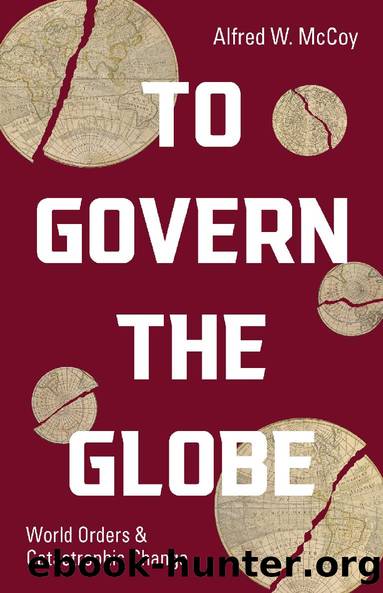To Govern the Globe by McCoy Alfred W

Author:McCoy, Alfred W.
Language: eng
Format: epub
Publisher: Haymarket Books
Published: 2021-11-15T16:00:00+00:00
James Van Fleet, commander of UN forces, Columbia Orphanage, Seoul, South Korea, 1952 (Credit: Authorâs Collection)
The president who presided over the military operations that had accompanied Americaâs ascent to global power was Dwight Eisenhower, the son of a failed general-store owner in Abilene, Kansas, and another member of the West Point class of 1915. During World War II, he had forged the Allied coalition that defeated the Germans in North Africa, mounted a massive amphibious landing in France, and breached Germanyâs last defenses. As president during the Cold War decade of the 1950s, he oversaw the synthesis of science, industry, and weapons procurement into what he called a âmilitary-industrial complexâ to maintain Americaâs technological edge.78
By the end of the Eisenhower presidency in 1960, the Pentagon had built a nuclear triad of weaponry that gave it âa virtually invulnerable strategic deterrent.â While the US Navyâs fleet of five nuclear-powered submarines cruised the ocean depths carrying sixteen nuclear-armed Polaris missiles each, its fourteen attack carriers, including the atomic-powered USS Enterprise, were also equipped for nuclear strikes. Moreover, the Strategic Air Command had 1,700 bombers ready to drop nuclear payloads on the Communist bloc, including six hundred behemoth B-52s with a range of eight thousand miles. Meanwhile, the Air Force had developed Atlas and Titan ballistic missiles that could carry nuclear warheads more than six thousand miles.79
Drawing on the countryâs economic strength, the Pentagon lavished fundsâgrowing rapidly from $33 billion annually in 1959 to $87 billion in 2009âon scientific research.80 Its close alliance with defense contractors produced incessant technological innovation, including the worldâs first system of global telecommunications satellites, which would evolve during the Cold War into its chief means for military navigation, intelligence, and communication.81 To exercise its dominion over the skies, Washington would elaborate on the British Empireâs doctrine of âfreedom of the seasâ to include the sky and even space, where its military satellites could orbit without restraint.82
Such a massive military apparatus rested on geopolitical foundations of extraordinary strength. As historian John Darwin has explained, Washington achieved its âcolossal Imperium ⦠on an unprecedented scaleâ after World War II by becoming the first power in history to control the strategic axial points âat both ends of Eurasia.â Indeed, when the Cold War reached Asia at the start of the Korean War in 1950, the National Security Council issued a memorandum (NSC-68) stating that âSoviet efforts are now directed toward the domination of the Eurasian land massâ and requiring that the US expand its military âto deter, if possible, Soviet expansion, and to defeat, if necessary, aggressive Soviet or Soviet-directed actions.â To encompass Eurasia, the defense budget increased almost fourfold from $13.5 billion to $48.2 billion, launching an increase of military appropriations that continues to this day.83 In defense of its dominance over that vast continent, Washington would, over the next 40 years, fight two hot wars in Korea and South Vietnam to check communist expansion, while the CIA waged large covert operations around its southern edge, probing relentlessly for vulnerabilities in the Sino-Soviet bloc.
Download
This site does not store any files on its server. We only index and link to content provided by other sites. Please contact the content providers to delete copyright contents if any and email us, we'll remove relevant links or contents immediately.
The Secret History by Donna Tartt(16658)
The Social Justice Warrior Handbook by Lisa De Pasquale(11494)
Thirteen Reasons Why by Jay Asher(7801)
This Is How You Lose Her by Junot Diaz(5798)
Weapons of Math Destruction by Cathy O'Neil(5046)
Zero to One by Peter Thiel(4834)
The Myth of the Strong Leader by Archie Brown(4795)
Promise Me, Dad by Joe Biden(4455)
Beartown by Fredrik Backman(4433)
Stone's Rules by Roger Stone(4422)
How Democracies Die by Steven Levitsky & Daniel Ziblatt(4413)
The Fire Next Time by James Baldwin(4350)
100 Deadly Skills by Clint Emerson(4085)
A Higher Loyalty: Truth, Lies, and Leadership by James Comey(4039)
Rise and Kill First by Ronen Bergman(4020)
The David Icke Guide to the Global Conspiracy (and how to end it) by David Icke(3891)
The Farm by Tom Rob Smith(3878)
Secrecy World by Jake Bernstein(3788)
The Doomsday Machine by Daniel Ellsberg(3737)
